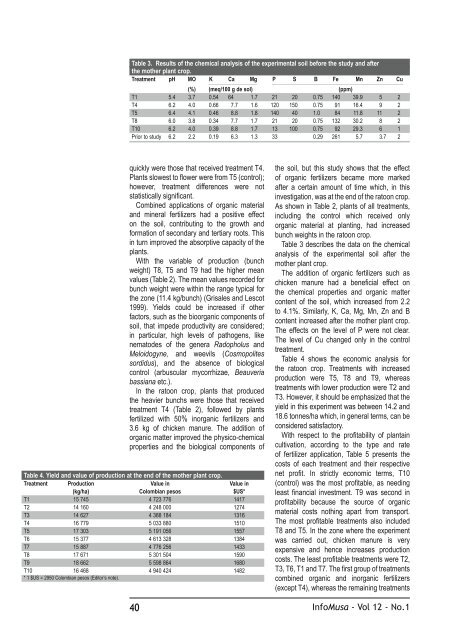Château-Musa - Bioversity International
Château-Musa - Bioversity International
Château-Musa - Bioversity International
Create successful ePaper yourself
Turn your PDF publications into a flip-book with our unique Google optimized e-Paper software.
Table 3. Results of the chemical analysis of the experimental soil before the study and after<br />
the mother plant crop.<br />
Treatment pH MO K Ca Mg P S B Fe Mn Zn Cu<br />
(%) (meq/100 g de sol) (ppm)<br />
T1 5.4 3.7 0.54 64 1.7 21 20 0.75 140 39.9 5 2<br />
T4 6.2 4.0 0.66 7.7 1.6 120 150 0.75 91 16.4 9 2<br />
T5 6.4 4.1 0.46 8.8 1.8 140 40 1.0 84 11.8 11 2<br />
T8 6.0 3.8 0.34 7.7 1.7 21 20 0.75 132 30.2 8 2<br />
T10 6.2 4.0 0.39 8.8 1.7 13 100 0.75 92 29.3 6 1<br />
Prior to study 6.2 2.2 0.19 6.3 1.3 33 0.29 261 5.7 3.7 2<br />
quickly were those that received treatment T4.<br />
Plants slowest to flower were from T5 (control);<br />
however, treatment differences were not<br />
statistically significant.<br />
Combined applications of organic material<br />
and mineral fertilizers had a positive effect<br />
on the soil, contributing to the growth and<br />
formation of secondary and tertiary roots. This<br />
in turn improved the absorptive capacity of the<br />
plants.<br />
With the variable of production (bunch<br />
weight) T8, T5 and T9 had the higher mean<br />
values (Table 2). The mean values recorded for<br />
bunch weight were within the range typical for<br />
the zone (11.4 kg/bunch) (Grisales and Lescot<br />
1999). Yields could be increased if other<br />
factors, such as the bioorganic components of<br />
soil, that impede productivity are considered;<br />
in particular, high levels of pathogens, like<br />
nematodes of the genera Radopholus and<br />
Meloidogyne, and weevils (Cosmopolites<br />
sordidus), and the absence of biological<br />
control (arbuscular mycorrhizae, Beauveria<br />
bassiana etc.).<br />
In the ratoon crop, plants that produced<br />
the heavier bunchs were those that received<br />
treatment T4 (Table 2), followed by plants<br />
fertilized with 50% inorganic fertilizers and<br />
3.6 kg of chicken manure. The addition of<br />
organic matter improved the physico-chemical<br />
properties and the biological components of<br />
Table 4. Yield and value of production at the end of the mother plant crop.<br />
Treatment Production Value in Value in<br />
(kg/ha) Colombian pesos $US*<br />
T1 15 745 4 723 776 1417<br />
T2 14 160 4 248 000 1274<br />
T3 14 627 4 388 184 1316<br />
T4 16 779 5 033 880 1510<br />
T5 17 303 5 191 056 1557<br />
T6 15 377 4 613 328 1384<br />
T7 15 887 4 776 256 1433<br />
T8 17 671 5 301 504 1590<br />
T9 18 662 5 598 864 1680<br />
T10 16 468 4 940 424 1482<br />
* 1 $US = 2950 Colombian pesos (Editor’s note).<br />
40<br />
the soil, but this study shows that the effect<br />
of organic fertilizers became more marked<br />
after a certain amount of time which, in this<br />
investigation, was at the end of the ratoon crop.<br />
As shown in Table 2, plants of all treatments,<br />
including the control which received only<br />
organic material at planting, had increased<br />
bunch weights in the ratoon crop.<br />
Table 3 describes the data on the chemical<br />
analysis of the experimental soil after the<br />
mother plant crop.<br />
The addition of organic fertilizers such as<br />
chicken manure had a beneficial effect on<br />
the chemical properties and organic matter<br />
content of the soil, which increased from 2.2<br />
to 4.1%. Similarly, K, Ca, Mg, Mn, Zn and B<br />
content increased after the mother plant crop.<br />
The effects on the level of P were not clear.<br />
The level of Cu changed only in the control<br />
treatment.<br />
Table 4 shows the economic analysis for<br />
the ratoon crop. Treatments with increased<br />
production were T5, T8 and T9, whereas<br />
treatments with lower production were T2 and<br />
T3. However, it should be emphasized that the<br />
yield in this experiment was between 14.2 and<br />
18.6 tonnes/ha which, in general terms, can be<br />
considered satisfactory.<br />
With respect to the profitability of plantain<br />
cultivation, according to the type and rate<br />
of fertilizer application, Table 5 presents the<br />
costs of each treatment and their respective<br />
net profit. In strictly economic terms, T10<br />
(control) was the most profitable, as needing<br />
least financial investment. T9 was second in<br />
profitability because the source of organic<br />
material costs nothing apart from transport.<br />
The most profitable treatments also included<br />
T8 and T5. In the zone where the experiment<br />
was carried out, chicken manure is very<br />
expensive and hence increases production<br />
costs. The least profitable treatments were T2,<br />
T3, T6, T1 and T7. The first group of treatments<br />
combined organic and inorganic fertilizers<br />
(except T4), whereas the remaining treatments<br />
Info<strong>Musa</strong> - Vol 12 - No.1

















